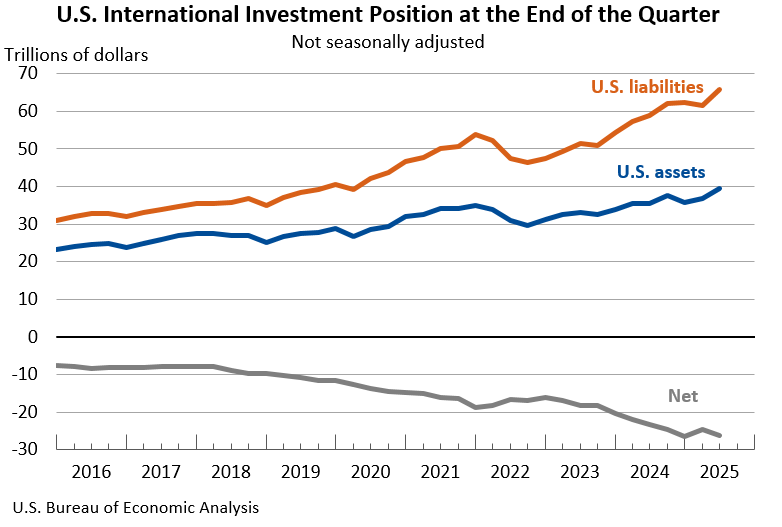Bureau of Economic Analysis
U.S. International Investment Position, 2nd Quarter 2025
The U.S. net international investment position, the difference between U.S. residents’ foreign financial assets and liabilities, was -$26.14 trillion at the end of the second quarter of 2025, according to statistics released today by the U.S. Bureau of Economic Analysis. Assets totaled $39.56 trillion, and liabilities were $65.71 trillion. At the end of the first quarter, the net investment position was -$24.65 trillion (revised).
Principal Federal Economic Indicators
Noteworthy
The Latest
Personal Income and Outlays, January 2020
Personal income increased 0.6 percent in January after increasing 0.1 percent in December. Wages and salaries, the largest component of personal income, increased 0.5 percent in January after increasing 0.1 percent in December.
GDP Increases in Fourth Quarter
Real gross domestic product (GDP) increased 2.1 percent in the fourth quarter of 2019, according to the “second” estimate released by the Bureau of Economic Analysis. The growth rate is the same as in the “advance” estimate released in January. In the third quarter, real GDP also increased 2.1 percent.
Gross Domestic Product, Fourth Quarter and Year 2019 (Second Estimate)
Real gross domestic product (GDP) increased 2.1 percent in the fourth quarter of 2019, according to the “second” estimate released by the Bureau of Economic Analysis. The growth rate is the same as in the “advance” estimate released in January. In the third quarter, real GDP also increased 2.1 percent.
Exploring the Space Economy
BEA has launched a research project to measure the multibillion-dollar U.S. space economy, such as satellites, rocket launches, and benefits like GPS navigation here on Earth.
The goal is to create a prototype set of statistics showing the space sector’s impact on the national economy. We are researching how to measure both public programs and private endeavors, with emphasis on capturing the value of the expanding commercial space…
December 2019 Trade Gap is $48.9 Billion
The U.S. monthly international trade deficit increased in December 2019 according to the U.S. Bureau of Economic Analysis and the U.S. Census Bureau. The deficit increased from $43.7 billion in November (revised) to $48.9 billion in December, as imports increased more than exports. The previously published November deficit was $43.1 billion. The goods deficit increased $5.1 billion in December to $69.7 billion. The services surplus decreased…
2019 Trade Gap is $616.8 Billion
The U.S. international trade deficit decreased in 2019 according to the U.S. Bureau of Economic Analysis and the U.S. Census Bureau. The deficit decreased from $627.7 billion in 2018 to $616.8 billion in 2019, as imports decreased more than exports. As a percentage of U.S. gross domestic product, the goods and services deficit was 2.9 percent in 2019, down from 3.0 percent in 2018. The goods deficit decreased from $887.3 billion in 2018 to $…
U.S. International Trade in Goods and Services, December 2019
The U.S. monthly international trade deficit increased in December 2019 according to the U.S. Bureau of Economic Analysis and the U.S. Census Bureau. The deficit increased from $43.7 billion in November (revised) to $48.9 billion in December, as imports increased more than exports. The previously published November deficit was $43.1 billion. The goods deficit increased $5.1 billion in December to $69.7 billion. The services surplus decreased $0.…
Personal Income and Outlays, December 2019
Personal income increased 0.2 percent in December after increasing 0.4 percent in November. Wages and salaries, the largest component of personal income, increased 0.3 percent in December after increasing 0.4 percent in November.
Personal Income and Outlays, December 2019
Personal income increased 0.2 percent in December after increasing 0.4 percent in November. Wages and salaries, the largest component of personal income, increased 0.3 percent in December after increasing 0.4 percent in November.
GDP Increases in Fourth Quarter
Real gross domestic product (GDP) increased 2.1 percent in the fourth quarter of 2019, according to the “advance” estimate released by the Bureau of Economic Analysis. In the third quarter, real GDP also increased 2.1 percent. Fourth-quarter GDP highlights The fourth-quarter increase in real GDP reflected increases in consumer spending, government spending, housing investment, and exports which were partially offset by decreases in inventory…




